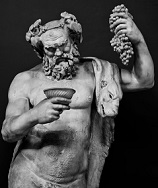
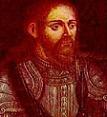


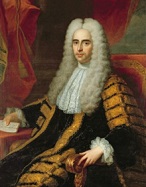
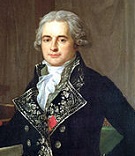






TLW's Winescope™ (Wine Historyscope) |
By T.L. Winslow (TLW), the Historyscoper™ |
© Copyright by T.L. Winslow. All Rights Reserved. |
Original Pub. Date: Aug. 9, 2016. Last Update: Aug. 26, 2025. |

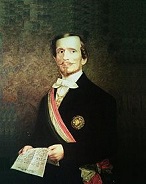
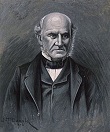

Westerners are not only known as history ignoramuses, but double dumbass history ignoramuses when it comes to wine, wine styles, wine history, viticulture, winemaking, winery, and wine producer history. Since I'm the one-and-only Historyscoper (tm), let me quickly bring you up to speed before you dive into my Master Historyscope.
Wine producing regions are limited to the temperate latitudes of 30-50 deg. in each hemisphere, with annual mean temps. of 10-20C (50-68F); the key to viticulture is cultivation of hermaphroditic members of the species Vitis vinifera.
About 6000 B.C.E. a pottery jar from a village near Lake Urmia on the Iranian Plateau has retsina (grape and pine resin) wine residue, indicating wine drinking?
About 6000 B.C.E. Wine is grown in the Caucasus Mts.
About 5400 B.C.E. grape (wine) residue is found in pottery jars in from the Zagros Mts. of N Iran.
About 4200 B.C.E. evidence of wine in pottery in Dikii Tash 1.2 mi. from ancient Philippi.
About 4100 B.C.E. the oldest known winemaking equipment is unearthed in Armenia near the Iranian border in 2007.
About 3125 B.C.E. the first wine discovered in Egypt in modern times is produced in Jordan and buried in the Scorpion King's tomb.
In 1818 B.C.E. Xia Fa dies, and Xia Jie (Hsia Chieh) (the Tyrant) becomes Xia king #17 of China; the first cruel Chinese king, he amuses himself by having 3K people drowned in a lake of wine - cruel, or euthanasia?
In 1700 B.C.E. Tel Kabri in N Israel is the oldest known wine cellar, containing 40 50-liter jars.
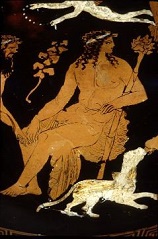


About 1500 B.C.E. the Greek wine god Dionysus begins to be worshiped by the Mycenean Greeks, later adopted by the Romans as Bacchus.
About 1000 B.C.E. the warlike red-haired blue-eyed Thracians (ancestors of the Swedes?) settle in N Greece, Bulgaria, and Turkey between the Aegean Sea, Carpathians, Black Sea, and Morava and Vardar Rivers, becoming known for their wine, exquisite works of gold, and the tombs of their chieftains filled with chariots, horses, weapons, and wives.

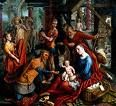
In spring 29 C.E. (15th year of the reign of Tiberius Caesar) (Luke 3:1-3) the ministry of (St.) John the Baptist (Baptiser) (-4 to 31) begins in the wilderness of Jordan (Matt. 3:1-12; Mark 1:1-8, Luke 3:1-18, John 1:6-28), and in the fall Jesus (Jehoshua) of Nazareth (-2 to 33) is baptized by him in the Jordan River, making him Jesus Christ (Gr. "anointed"), and launching his ministry as the Jewish Messiah (Heb. "anointed") (Matt. 3:13-17, Mark 1:9-11, Luke 3:21-38, John 1:32-34); Jesus goes solo into the Judean wilderness to fast and resist the temptations of Satan, who owns all world govts. (Matt. 4:1-11, Mark 1:12-13, Luke 4:1-13), then makes his first disciples in the Upper Jordan Valley (John 1:35-51); meanwhie John testifies concerning Jesus in Bethany beyond Jordan (John 1:15; 29-34); Jesus performs his first miracle (turns water into wine) at a Wedding Feast in Cana of Galilee (his own?), then visits Capernaum (John 2:1-12).
About 50 C.E. the Romans introduce Bordeaux wine to SW Gaul (France).
In 70 C.E. the Romans build the small Duroliponte Fort on Castle Hill near modern-day Cambridge, England on the Cam River 50 mi. N of London (modern-day pop. 131K/280K), which becomes a town in about 120; after the Romans leave Britain in 410, the Anglo-Saxons begin occupying it, founding Grantebrycge (Granta-bridge) on the border between East Anglia and Middle Anglia; in 875 the Vikings occupy it, causing the pop. to grow, shifting from Castle Hill on the left bank to Quayside on the right bank; in the 10th cent. the Saxons return to power, striking coins calling the town "Grant"; in 1068 William I the Conqueror builds a castle on Castle Hill; the first town charter is granted by Henry I in 1120-31, giving it a monopoly on waterborne traffic and tolls; in 1209 Cambridge U. is founded by students running from hostile townsfolk in Oxford; the Romans build their first vineyard irrigation system in Britain around Duroliponte.
In 789 C.E. Vino Nobile di Montepulciano red wine, produced in Montepulciano, S Tuscany, Italy is first mentioned, later on Oct. 17, 1350, and in 1685 by poet Francesco Redi, who calls it "the king of all wines".
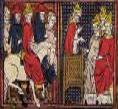
On Mar. 12, 1088 Odo (Udo) (Otho) (Otto) of Lagery (Chatillon) (a Cluny Benedictine monk born in Chatillon-sur-Marne) is elected Pope (#158) Urban II (1042-99) (2nd French pope after Sylvester II in 999) (Pope Urban I was in 220-30), continuing the fight with Antipope Clement III, excommunicating him and defeating his forces in Rome, and reexcommunicating Henry IV over his demands about investiture; meanwhile pissed-off Prague bishop Jaromir comes to Rome to protest the new Moravian bishop Andrew I, then dies in Esztergom in N Hungary as he prepares to fight him, causing Jaromir to storm off to Rome to protest to Pope Urban II; being from the Champagne region of NE France, the pope declares that the wine of Champagne (Ay) 100 mi. E of Paris is the best in the world.


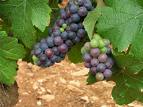
In 1093 after giving up on inheriting Burgundy from his older brothers and joining the Reconquista in Spain, then helping Alfonso VI of Castile-Leon conquer Galicia and N Portugal, French knight Henrique (Henry) of Burgundy (1066-1112) founds the County of Portugal with lands given him by Alfonso VI, marrying his illegitimate daughter (by Ximena Moniz) Theresa of Portugal (1080-1130) and becoming Count Henrique I of Portugal (his son makes it a kingdom), founding the long-lived "We're #2, We Try Harder" Avis Dynasty of Portuguese rulers (ends 1580); not the kind to be caught without something to drink, he introduces the Pinot noir grape into Portugal from France, becoming the forerunner of modern port wines; the old Celtic town of beautiful Braga, held by the ancient Romans (as Bracara Augusta), Suevi, Visigoths and Moors becomes the capital of Portugal (until 1147).
In 1114 Pontigny Abbey in the Yonne dept. of France in N Burgundy halfway between Paris and the Cote d'Or is founded by 12 Cistercian monks sent by Abbot Stephen Harding of Citeaux led by Hugh of Macon, friend and kinsman of Bernard of Clairvaux, becoming the 2nd of four great daughter houses of Citeaux Abbey, which goes on to establish 22 more Cistercian monasteries that later give refuge to St. Thomas Becket, Centerbury Archbishop Stephen Langton, and St. Edmund of Abingdon; it is closed in 1456, and burned down in 1569 by Huguenots; the monks go on to plant vines along the Serein River, producing dry white wine known as Chablis wine, known for its gunflinty aftertaste ("goűt de pierre ŕ fusil").




On Mar. 18, 1152 the 1137 marriage of 30-y.-o. Eleanor of Aquitaine (1122-1204) to Louis VII of France is annulled (officially due to lack of a male heir, but maybe because she had an affair during the Second Crusade?), and on May 18 she marries more plantworthy 19-y.-o. Henry Plantagenet (Curtmantle) (1133-89), Duke of Normandy and Count of Anjou, Maine, and Touraine (future Henry II), giving him control of over half of France with the power to pressure Louis' holdings from both N and S, causing Louis to feel that he has been robbed blind of her vast estates and cut off from direct access to the English Channel and the Atlantic, beginning a long struggle between England and France over Aquitaine (ends 1558); the Bordeaux and Graves areas of SW France on the left bank of the Garonne River between St. Pierre de Langon and Bordeaux in Guienne (Guyenne), known for their fine wines go to him, and the English begin turning into claret drinkers.
In 1240 English Franciscan scholar Bartholomeus Anglicus (Bartholomew or Berthelet the Englishman) (1202-72) pub. De Proprietatibus Rerum (On the Properties of Things) (19 vols.) in Magdeburg, Saxonia, a forerunner of the encyclopedia, incl. a dissertation on the brain, recognizing that mental disorders can have a physical or psychological cause, and containing the first mention of Muscat (Lat. "muscus" = "fly", as in so sweet it attracts them) wine; it is trans. into French in 1372, and into English in 1397.
On Oct. 9, 1264 after the Muslim pop. surrenders in 1261 after a mo.-long siege, then rebels, Castile captures Jerez (Xerez) de la Frontera, which after the 1492 conquest of Granada becomes one of the most prosperous cities in Andalusia, trading with the ports of Cadiz and Seville, going on to export Sherry fortified wine, which was first produced after the Moors conquered the area in 711 and introduced distillation.
About 1300 Paris-based Dominican Jofroi of Waterford pub. Catalogue of All Known Wines and Ales of Europe, recommending his favorites to his colleagues.
On June 16, 1373 the first regular shipment of wine from Portugal to England twenty years earlier results in the Treaty of Perpetual Friendship, becoming the most enduring internat. alliance of all time; Portugal receives fishing rights off the English coast in order to encourage the wine trade; ask somebody what this has to do with Port Wine.
In the 16th cent. C.E. Spanish settlers from Castile planting Listan (Listán) Prieto (negro) ("Listan" = "Palomino") grapes in the Canary Islands, which are later brought to the Spanish colonies in Peru, and in Calif. in the late 18th cent. by Franciscan missionaries, where they become known as Mission grapes.
In the 16th cent. C.E. Spanish settlers in Peru-Chile begin making Pisco high-proof yellow-colored brandy as an alternative to the more expensive orujo pomace (marc) (wine skin) brandy imported from Spain.
In 1531 the Abbey of Saint-Hilare in the Limoux region of Languedoc in S France begins producing France's first sparkling wine; Dom Perignon's doesn't come out until 1693.
On May 15, 1571 the Furmint (Lat. "froment" = wheat-gold color) grape is first mentioned as growing in the Hetszolo Vineyard in Tokaj, Hungary. In 1630 Mate (Maté) Szepsy Laczko of Hungary invents the method for producing sweet Tokaj (Tokay) wine from botrytised furmint grapes (infected with botrytis cinera).
In Apr.-June 1587 the English under Sir Francis Drake attack the Spanish Armada at Cadiz and Lisbon, delaying it for more than a year; at Cape St. Vincent he destroys their food and water barrels, and captures a huge haul of Spanish treasure in the Azores, incl. 2.9K barrels of sherry, making it popular in Britain.
In 1589 Pineau des Charents fortified aperitif wine is accidentally discovered after an apprentice winemaker in the Charente dept. of SW France (part of the Cognac region) adds grape must to a barrel he believed to be empty but which contained eau de vie (cognac), and is allowed to age for a few years.
In 1590 Ciriegiulo, alias of Italian Florentine agronomist Giovan Vettorio Soderini (1526-96) pub. the first mention of Sangiovese (Lat. "sanguis Jovis" = blood of Jove or Jupiter) grapes from C Italy incl. Romagna, Lazio, Campagnia, and Sicily, which goes on to be mixed into Brunello di Montalcino, Rosso di Montalcino, Carmignano, Chianti, Vino Nobile di Montepulcian, and Morellino di Scansano, Sangiovidi di Romagna, and Tignanello; it was grown since the time of the ancient Etruscans? In 1600 he pub. Trattato della coltivazione delle viti, e del frutto che se ne puo cavare (Treatise on the Cultivation of the Vineyard, and the Fruit That Can Be Obtained), a treatise on viticulture and oenology, claiming that the stars influence the harvest.
In 1593 Prosecco sparkling white wine from NE Italy (named after a village near Trieste) is first mentioned by English traveler Fynes Moryson (Morison) (1566-1630), who claims it is a recreation of Pucinum, the wine celebrated by Pliny the Elder in his Natural History and Roman emperor Augustus' wife Livia for its medicinal qualities.


The original Supersize Me? On Aug. 4, 1693 blind French Benedictine monk Dom Pierre Perignon (1638-1715) invents Champagne, which is later sold in supersized bottles called Magnum (2x), Jeroboam (4x), Rehoboam (6x), Methuselah (8x), Salmanazar (12x), Balthazar (16x), and Nebuchadnezzar (20x) (My Judy Really Makes Splendid Belching Noises); actually, he didn't invent sparkling wine, just taught blending skills and figured out how to bottle the stuff in reinforced glass bottles sealed with Spanish corks?

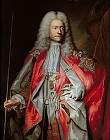
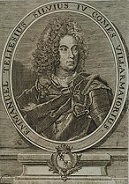
In May 1703 after English naval Vs against Spain permit England to detach Portugal from its French alliance, English ambassador John Methuen (1650-1706) negotiates the two Methuen Treaties, the first a 4-sided treaty, negotiated by Methuen with the help of his son Sir Paul Methuen (1672-1757) for England, Karl Ernst, Graf von Waldstein for HRE Joseph I, Franciscus van Shonenberg (AKA Jacob Abraham Belmonte) (a Marrano) for the United Provinces, and King Pedro II for Portugal, establishing an offensive-defensive alliance between Britain and Portugal, and promising to send the emperor's son Archduke Charles (later HRE Charles VI) to Portugal with land forces to win the crown of Spain, along with naval protection of the Portuguese coast against French and Spanish attack, followed by the 2nd on Dec. 27 with John Methuen signing for England, and Manuel Teles da Silva, 3rd Marquis de Alegrete (1682-1736) signing for Portugal, giving Portuguese (port) wines (grown in the Douro (Duero) River Valley in N Portugal and shipped in rabelo boats the Atlantic port of Porto) a one-third break on English duties in return for Portugal agreeing to import all its woolens from England duty-free, which, combined with the war with France depriving English drinkers of French wine causes the popularity of Portuguese port wine in England to zoom (not just for Whigs anymore?); meanwhile the Portuguese renounce manufacturing (except porcelain) in order to guarantee the security of Brazil, losing the Industrial Rev.?; too bad, while returning from Lisbon, Waldstein is captured at sea by the French, and exchanged a year later for Villeroi, who was captured in Italy by Prince Eugene.

In 1716 the province of Chianti in C Tuscany, Italy between Florence and Sienna becomes an official wine-producing region, defined as the area around the villages of Gaiole, Castellini, and Rada; in 1932 it is redrawn and divided into seven sub-areas, incl. Classico, Colli Aretini, Colli Fiorentini, Colline Pisane, Colli Senesi, Montalbano, and Rufina; they have been producing wine since the 14th cent; it is traditionally sold in a squat bottle in a straw basket (It. "fiasco"), with a black rooster (gallo nero) seal; in the mid-19th cent. "Iron Baron" Bettino Ricasoli, 2nd Baron Ricasoli (1809-80) (Italian PM #2 in 1866-7) creates the traditional Chianti recipe of 70% Sangiovese, 15% Canaiolo, and 15% Malvasia bianca from his Castello di Brolio in Gaioli in Chianti 12 mi. NE of Siena.
In 1772 Veuve Clicquot Ponsardin champagne house in Reims, France is founded by Philippe Clicquot-Muiron, going on to pioneer advancements in the methode champenoise via the technique of remuage, producing the 1811 comet vintage, the first truly modern champagne, which becomes the favorite drink of the nobles and haute bourgeoisie of Europe.
In 1774 Eiswein (Icewine) (sweet wine from grapes that are allowed to freeze on the vine) is discovered by accident in the Franconia wine region of Germany near Wurzburg.
In 1784 the earliest recorded mention of Merlot (Fr. "young blackbird") wine is made by an official in Bordeaux, France.

In 1806 French chemist Jean-Antoine Chaptal, Comte de Chanteloup (1756-1832) pub. La Chimie Appliquee aux Arts, describing the Chaptalization process of adding sugar to increase final alcohol content, revolutionizing winemaking in France.
In 1811 French astronomer Honore Flaugergues (Pierre-Gilles-Antoine-Honoré Flaugergues) (1755-1835) discovers the Great Comet of 1811 (C/1811 F1) in the constellation Argo Noves, causing wine of vintage 1811 to be called wine of the comet.

In 1825 Scottish-born British Australian immigrant (1824) James Busby (1802-71) pub. Treatise on the Culture of the Vine, after which he visits England in 1828, followed by Spain and France, returning to Australia in 1828 with the first collection of Spanish-French wine stock. In 1831 Black Hermitage Syrah (Shiraz) grapes are brought to Australia from France and Spain by Busby, causing him to become known as "the Father of the Australian Wine Industry".
In 1844 Adolphe Jacqueson of France invents the muselet (Fr. "museler" = to muzzle), the wire cage that secures the cork in a bottle of champagne.

In 1849 after planting 22K seedlings of the indigestible hard-skinned fox (skunk) grape Vitis labrusca in an attempt to develop a palatable wine from "pure" native Am. species to get around the "debauched" European and Semitic species Vitis vinifera, the slip-skin Concord Grape is invented by Boston-born gold leaf artisan and amateur farmer Ephraim Wales Bull (1806-95) of Concord, Mass.; too bad, after he fails to obtain a patent others begin growing and selling them, turnng them into grape juice, jelly, Communion and sacramental wine, and Kosher wine; his epitaph reads "He sowed others reaped."
In the 1850s the zinfandel grape is brought into Calif. from Vienna, Austria (becoming the most commonly grown kind in Calif. until ?), along with the soybean from Japan and alfalfa seed from Chile.
In the 1850s Cincinnati, Ohio hosts a winemaking industry based on Catawba grapes.
In the mid-1800s the Mo. Rhineland is established in the Missouri River Valley by German immigrants, stretching from Marthasville, Mo. W to Jefferson City.
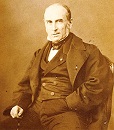
On May 15-Nov. 15, 1855 the first Exposition Universelle (World's Fair) is held in Paris, organized by Pierre Guillaume Frederic le Play (1806-82), and attracting 5M visitors, incl. Queen Victoria; it creates the 1855 Bordeaux Wine Official Classification, assigning the classification of premier cru (first growth) to Chateau Latour, Chateau Lafite Rothschild, Chateau Margaux, and Chateau Haut-Brion, all located in Medoc except Haut-Brion, which is in Graves; the Manny Reaper beats the McCormick Reaper, causing Cyrus McCormick to sue for patent infringement, hiring atty. Reverdy Johnson, while John H. Manny hires George Harding, Edwin M. Stanton, and young Abraham Lincoln, who ends up being told to sit in the audience because he looks like a "long-armed baboon" and dirty clothes, humiliating him, but forcing him to become a better lawyer?; Manny wins.
In 1858 the Great French Wine Blight begins when the tiny pale yellow sap-sucking Grape phylloxera insect pest of the aphid family is accidentally introduced into France grapevines from the E U.S., and infects vines throughout S Europe before spreading worldwide, destroying the French wine industry until new vines combining the resistant Am. rootstock are grafted to Euro vines.

In 1861 the Calif. state legislature commissions Hungarian-born Count Agoston Haraszthy (1812-69) to bring select varieties of European wine grapes to the state, and he spends $12K of his own money to bring in 100K cuttings representing 300 varieties from Europe's great vineyards, inaugurating modern Calif. wine production; and becoming known as "the Father of Calif. Viticulture"; in 1863 two of his sons marry daughters of Spanish-born Mexican gen. Mariano Guadalupe Vallejo (1807-90), assuring a supply of good land.
In 1865 Great Western Champagne is introduced by the Pleasant Valley Wine Co. of Hammondsport, N.Y. (founded 1860), becoming the first N.Y. sparkling champagne.
In 1880 the Petite Sirah (Durif) red wine grape, known for its spicy plummy flavor is created by crossing Syrah with Peloursin.
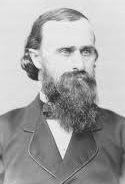
On Aug. 28, 1881 after Congress passes the U.S. Ute Removal Act, reneging on a guarantee of 12M acres in perpetuity, the former Ute Indian Territory is abolished and the Utes removed from their "Shining Mountains" to a rez in E Utah so that the U.S. govt. can open the area to white settlers, incl. Clinton County, Penn.-born George Addison Crawford (1827-91), who next July 22 incorporates the town of Grand Junction, Colo. (AKA River City, Ol' Grandy, Capital of the Western Slope) in Grand Valley on the W slope of the Rockies at the confluence of the Grand (Upper Colorado) and Gunnison Rivers (modern-day pop. 60K/147K), and plants the first vineyard in Colo. near Palisade, after which the area becomes known as the Colo. Wine Country.

In 1920 English wine connoisseur George Saintsbury (1845-1933) pub. Notes on a Cellar-Book, which becomes a big hit among wine drinkers, causing the Saintsbury Club for lit. men and members of the wine trade to be founded.
In 1927 viticultural boundaries are defined in the Champagne wine region of NE France 100 mi. E of Paris, which is split into five wine-producing districts incl. the Aube, Cote des Blancs, Cote de Sezanne, Montagne de Reims, and Vallee de la Marne, which covers 76K acres of vineyards and 319 villages with 5K growers who make their own wine and 14K growers who only sell grapes; in 2008 France allows 40 new villages to classify themselves as part of the Champagne wine region, with 319 more villages slated for inclusion in the near future.
On May 24, 1976 the Judgment of Paris (1976 Paris Wine Tasting), a blind taste test in the Paris Inter-Continental Hotel sees Calif. wines beat French wines, causing French judge Odette Kahn to demand her ballot back and diss the results.
On June 20, 1980 Augusta AVA in Mo. becomes the first federally recognized Am. Viticultural Area (AVA) in the U.S., followed next Feb. by the Napa Valley AVA; by Mar. 2015 there are 230.
On Apr. 23, 1989 William "Bill" Sokolin breaks a bottle of Chateau Margaux wine once owned by Thomas Jefferson (1787) at the Four Seasons restaurant in New York City.
In 2002 Two Buck Chuck (Charles Shaw brand) Calif. wines are introduced by Trader Joe's grocery stores in Calif. at $1.99/bottle, going on to sell 800M bottles.
On Mar. 4, 2022 Remi Daviet et al. of the U. of Penn. pub. the article Associations between alcohol consumption and gray and white matter volumes in the UK Biobank in Nature Communications, revealing the results of a study of 36K+ MRI brain scans that drinking four units of alcohol a day (two beers or glasses of wine) causes brain structural damage and volume loss equivalent to 10 years of aging - a reason to quit before you reach 90?